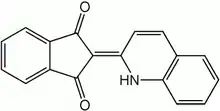Quinaldine
Quinaldine or 2-methylquinoline is an organic compound with the formula CH3C9H6N. It is one of the methyl derivative of a heterocyclic compound quinoline. It is bioactive and is used in the preparation of various dyes. It is a colorless oil but commercial samples can appear colored.[1]
 | |
| Names | |
|---|---|
| IUPAC name
2-Methylquinoline | |
| Other names
Quinaldine, α-methylquinoline, chinaldine, khinaldin | |
| Identifiers | |
3D model (JSmol) |
|
| ChEMBL | |
| ChemSpider | |
| ECHA InfoCard | 100.001.896 |
| EC Number |
|
PubChem CID |
|
| UNII | |
CompTox Dashboard (EPA) |
|
| |
| |
| Properties | |
| C10H9N | |
| Molar mass | 143.19 g/mol |
| Appearance | colorless oil |
| Density | 1.058 g/cm3 |
| Melting point | −2 °C (28 °F; 271 K) |
| Boiling point | 248 °C (478 °F; 521 K) |
| Insoluble | |
| Hazards | |
| Main hazards | Harmful (Xn), Corrosive (C) |
| R-phrases (outdated) | R21/22 R34 |
| NFPA 704 (fire diamond) | |
| Flash point | 79 °C (174 °F; 352 K) |
Except where otherwise noted, data are given for materials in their standard state (at 25 °C [77 °F], 100 kPa). | |
| Infobox references | |
Production and reactions
It is recovered from coal tar. It can be prepared from aniline and paraldehyde via Skraup synthesis or from aniline and crotonaldehyde via Doebner-von Miller variation of the Skraup reaction.[1]
Hydrogenation of quinaldine gives 2-methyltetrahydroquinoline. This reduction can be conducted enantioselectively.[2]
Uses
Quinaldine is used in manufacturing anti-malaria drugs, dyes and food colorants (e.g., Quinoline Yellows, pinacyanol). It is the precursor to the pH indicator Quinaldine Red.


Quinaldine sulfate is an anaesthetic used in fish transportation.[3] In some Caribbean islands it is used to facilitate the collection of tropical fish from reefs.
Quinaldine has critical point at 787 K and 4.9 MPa and its refractive index is 1.8116.
References
- Gerd Collin; Hartmut Höke. "Quinoline and Isoquinoline". Ullmann's Encyclopedia of Industrial Chemistry. Weinheim: Wiley-VCH. doi:10.1002/14356007.a22_465.
- Chen, Fei; Ding, Zi-Yuan; He, Yan-Mei; Fan, Qing-Hua (2015). "Synthesis of Optically Active 1,2,3,4-Tetrahydroquinolines via Asymmetric Hydrogenation Using Iridium-Diamine Catalyst". Org. Synth. 92: 213–226. doi:10.15227/orgsyn.092.0213.
- Blasiola G. C. Jr. (1977). "Quinaldine sulphate, a new anaesthetic formulation for tropical marine fishes". Journal of Fish Biology. 10 (2): 113–119(7). doi:10.1111/j.1095-8649.1977.tb04048.x.
External links
- MSDS at Science Lab
- Method of purifying quinaldine
- Chisholm, Hugh, ed. (1911). . Encyclopædia Britannica. 22 (11th ed.). Cambridge University Press. pp. 758–760.
